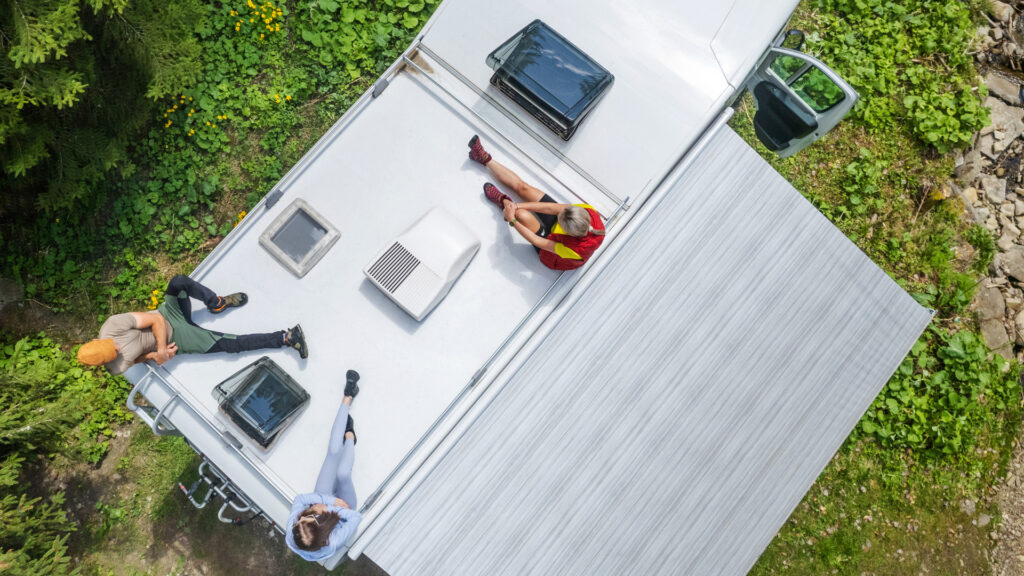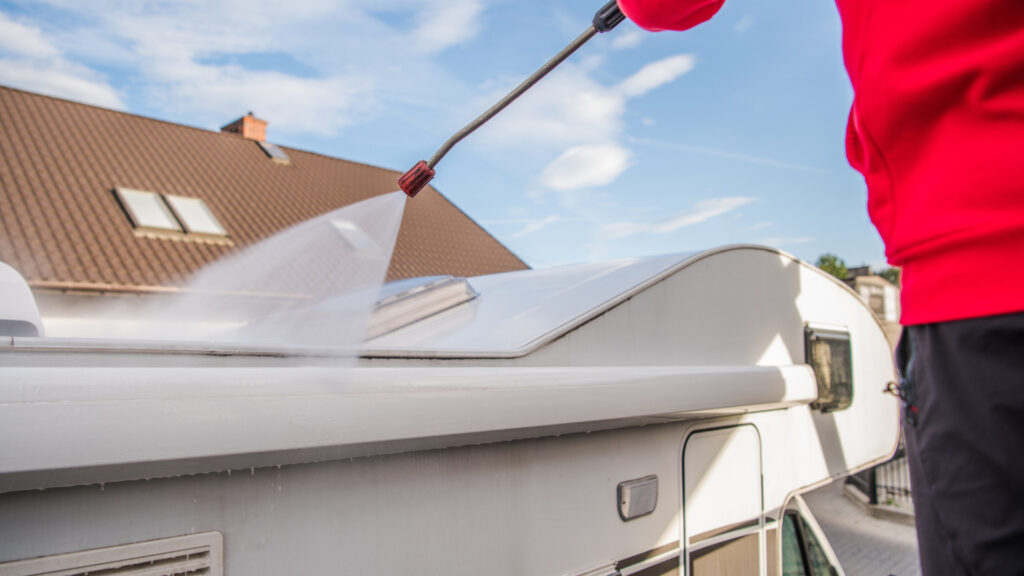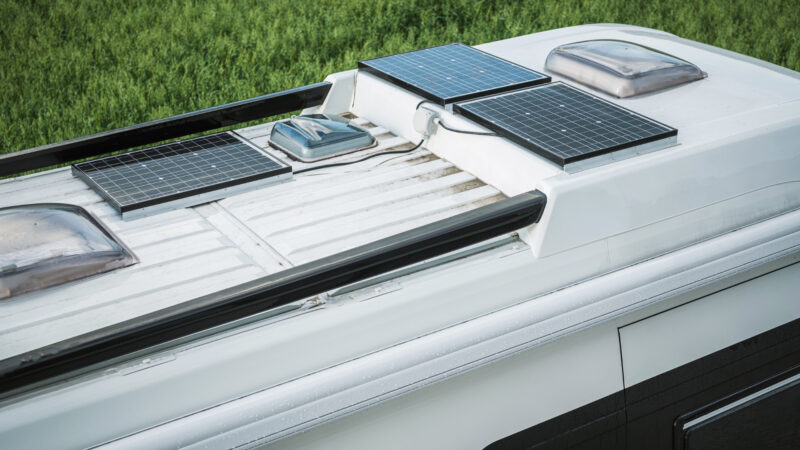Table of Contents Show
Maintaining your RV’s roof is essential because your rubber roof coating will wear down over time. Taking action to keep your roof in good repair will give you many more years to enjoy a dry environment inside of your favorite RV or camper.
If you own an RV, you already know it brings out the DIY spirit. Fixing things on your RV is a regular part of ownership, and roof maintenance is no different.
You can totally tackle the job of refurbishing your rubber roof coating. All you need is a little guidance. Here are a few poignant questions and answers below.
Types of Rubber RV Roofs
To start your RV roofing education, you must first understand the various types of roofing you could encounter along the way.
Using the proper materials to add more protection to your roof is vital to ward off any future leaks or troubles.
Different materials come in different thicknesses.
The thickness of rubber RV roofs are measured in “mils” regardless of material.
A Mil is a unit of measurement denoting a thousandth of an inch. If you want to convert the mil to inches, all you need to do is take the mil and divide by 1000.
Here are brief descriptions of three different types of RV roofs.
TPO
TPO stands for thermal polyolefin.
This rubber roof is easy to identify because both sides of the roof material will be the same color.
TPO roofing is typically good for 10 to 20 years.
It’s one of the most common types of membranes used on flat roofs.
Most of the time, a TPO roof membrane will be white, but they come in a couple of different colors.
Thermal polyolefin roofs are somewhat thin. They’re usually a little more than 30 – 70 mil in thickness.
EPDM
EPDM stands for ethylene propylene diene monomer.
It’s a mouthful, we know!
If you have an EPDM roof on your RV, one side of the material will be white, and the other will be black.
The feel of the membrane will almost always present as smooth because it has no surface granules.
EPDM can be thinner than TPO roofing. It’s only usually 45 mil thick but you can find 60 – 90 mil thicker options.
This roof type will last over 25 to 30 years if properly maintained.
Pro Tip: Roof issues can cause a lot of damage. Take care of your roof with these products to repair your RV roof.
PVC
PVC stands for polyvinyl chloride. Its roof membranes are the popular choice for simple installation and affordability.
You can find PVC roofing in several colors, and sometimes you can even find it in a shingle pattern.
It’s low maintenance and doesn’t require owners to UV treat the membrane yearly.
Depending on the manufacturer, a PVC roof could range anywhere from 27 – 80 mil in thickness.
Can a Rubber RV Roof Be Coated?
Your RV’s rubber roof membrane can be coated with a paintable coating that will reinforce the waterproofing of your camper.
The products on the market specifically work alongside your rubber roof coating to extend the lifetime of your RV.

Can You Coat a Rubber Roof Yourself?
You can totally do this job yourself.
You probably won’t even need a buddy to help with the work.
It will all have to be done in one day to get the best result, so you’ll have to have the whole day set aside to finish everything.
Adding a rubber roof coating to your existing rubber roof membrane can be completed in just a few steps, but the steps take a while to complete.
You’ll want to start the job early in the morning so you have enough daylight for the second coating to set properly.
What’s the Best Coating for a Rubber Roof?
Two-Part Dicor EPDM Rubber Roof Coating
- USE: This roof coating system extends the life of an EPDM rubber roof on RVs..Fit Type: Universal Fit
- EASY TO USE: Saves more than 25 percent in labor compared to competing products
- USE: Well suited for retrofit installations; Protective barrier for extending the life of the EPDM rubber membrane on RV...
- COLOR: White hue for stylish and beautiful RV roof
If you find that your RV has an EPDM rubber roof membrane, a two-part Dicor EPDM rubber roof coating is the best for the job.
Spray the first part of the process onto the roof’s surface. You then let it sit for fifteen minutes before taking a pressure washer to the roof.
The first product is to help strip all the extra dirt and debris from your base membrane.
The second step in the process is the actual rubber coating that seals the membrane.
You’ll need two applications for part two.
Most RVs take 3 to 5 gallons to complete the job.
Heng’s Rubber Roof Coating
- Designed for use over RV rubber roofs, at seams and tears and to seal vents, air conditioners, etc.
- It is UV resistant and expands and contracts with roofs
Heng’s is another quality option on the market.
Going the route of Heng’s rubber roof coating is a little bit less expensive than the Dicor two-step process.
At around $65 a gallon, it’s about $20 cheaper than the alternative.
Keep in Mind: Stay safe working on your RV roof with one of these RV Ladders to reach your roof!
How Do You Prepare an RV Rubber Roof for Coating?
Prepping the roof for a rubber coating is extremely important to the overall success of the whole project.
If you don’t clean the surface well, you’ll have trouble getting it to adhere properly.
Cleaning the roof is crucial.
You’ll also want to shore up any rips or tears in your rubber roof membrane with a special RV roof tape.
Make sure all the seals around the various openings in your roof are also cleaned up and refreshed.
Once everything is cleaned and dry, you can proceed with the process of applying a new rubber coating on your roof.

How Often Should You Use RV Rubber Roof Coating?
How often you use RV rubber roof coating on your roof varies by product.
Depending on the type of roof you’re considering and the materials used to add a protective coating, you should repeat this process every 3 to 5 years.
Is Flex Seal Good for Rubber RV Roof?
Flex Seal will work to seal up your roof, but there are some troubling issues to consider before you go slapping this product on your rubber membrane.
Flex Seal is silicone, which will leave a residue that will make it difficult for anything else to stick to its surface.
This seems like a great thing until you need to recoat your roof.
Future repairs will be much more difficult.
Flex Seal shouldn’t be a go-to material for recoating your RV’s rooftop.
Last update on 2024-10-22 / Affiliate links / Images from Amazon Product Advertising API









